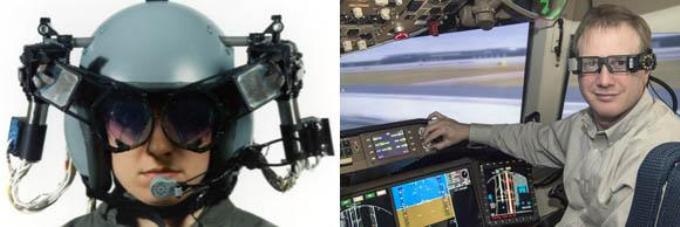May 24 2017
Wearable visualization systems (WVS) are presently at the forefront of consumer electronics product development, and social media companies are investing a lot to enable compelling experiences via augmented and virtual reality (AR/VR).
 Vintage and next-generation head-worn displays are featured in an article by NASA Langley authors in the special section (doi:10.1117/1.OE.56.5.051405): Fig 2. (left) Monochrome binocular HMD circa 1991, 6.5 pounds. Fig 6. (right) Lumus DK-32 display glasses coupled with a prototype head tracker made by Thales Visionix (Credit: The Authors)
Vintage and next-generation head-worn displays are featured in an article by NASA Langley authors in the special section (doi:10.1117/1.OE.56.5.051405): Fig 2. (left) Monochrome binocular HMD circa 1991, 6.5 pounds. Fig 6. (right) Lumus DK-32 display glasses coupled with a prototype head tracker made by Thales Visionix (Credit: The Authors)
A special section on Wearable Vision Systems: Head/Helmet-Mounted Displays in this month's issue of Optical Engineering, published by SPIE, the International Society for Optics and Photonics, aims to help promote consumer-driven advances in applications in industrial, automotive and military vision systems.
Significant commercial investment in WVS for personal communications and entertainment is driving rapid advances in miniature optoelectronics components and product design.
Guest Editors Darrel Hopper (Air Force Research Lab), James Melzer (Thales Visionix, Inc.), Michael Browne (SA Photonics) and Peter Marasco (U.S. Air Force Research Lab)
Their goal with the special section is to assist consumer-driven progress in the design of specialty applications including industrial, automotive and military vision systems.
The editorial lists main challenges, including achieving performance in a near-to-eye (NTE) visualization system sufficient to compel users to tolerate limitations including acuity, latency, fashion, field-of-view, and donning and doffing.
VR plunges viewers into an artificial environment elaborately characterized by ultrahigh-definition graphics, while AR encompasses imagery superimposed over the real world that can be perceived in real time. Accurate tracking of head, position and eye is required for certain VR and all AR applications.
Various research papers in the section describe a variety of technologies and approaches.
In "Daylight luminance requirements for full-color, see-through, helmet-mounted display systems," Thomas Harding and Clarence Rash (U.S. Army Aeromedical Research Lab and Oak Ridge Institute for Science and Education) describe two lines of investigation in luminance requirements to address visual perception issues of concern when color is applied in eyes-out, see-through helmet-mounted displays.
"Review of head-worn displays for the next-generation air transportation system" by Jarvis (Trey) Arthur et al. (NASA Langley Research Center), provides a summary of the results of NASA's 30-plus years of helmet-mounted and head-worn displays. The research tracks advancements in wearable collimated optics, latency, head tracking and weight reduction, as well as operational, safety, and cost benefits.
A "Review of conformal displays: more than a highway in the sky" by Niklas Peinecke et al., German Aerospace Center, reviews over four decades of research in synthetically generated symbols such as routing information, obstacle warnings, specialized landing displays, navigation aids, drift indicators, and others. The research also predicts research trends for the years to come.
Other papers in the special section include:
- "Application of large head-box aircraft transparency distortion measurement and compensation for improved cueing in helmet-mounted displays" by Mark Fischler et al., Thales Visionix Inc
- "Conformal displays: human factor analysis of innovative landing aids" by Sven Schmerwitz et al., German Aerospace Center
- "Optical alignment procedure utilizing neural networks combined with Shack-Hartmann wavefront sensor" by Fatime Adil, Aselsan MGEO Division, et al
- "Optical design of ultra-short throw liquid crystal on silicon projection system" by Jiun-Woei Huang, National Applied Research Laboratories, Taiwan